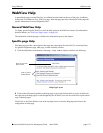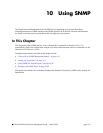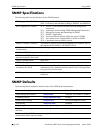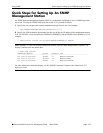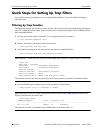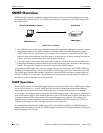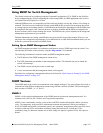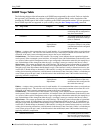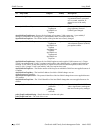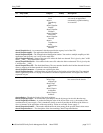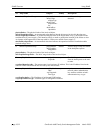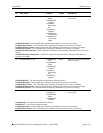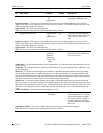
Using SNMP SNMP Overview
OmniSwitch 6600 Family Switch Management Guide March 2005 page 10-7
Using SNMP for Switch Management
The Alcatel switch can be configured using the Command Line Interface (CLI), SNMP or the WebView
device management tool. When configuring the switch using SNMP, an NMS application (such as Alca-
tel’s OmniVista or HP OpenView) is used.
Although MIB browsers vary depending on which software package is used, they all have a few things in
common. The browser must compile the Alcatel switch MIBs before it can be used to manage the switch
by issuing requests and reading statistics. Each MIB must be checked for dependencies and the MIBs must
be compiled in the proper order. Once the browser is properly installed and the MIBs are compiled, the
browser software can be used to manage the switch. The MIB browser you use depends on the design and
management requirements of your network.
Detailed information on working with MIB browsers is beyond the scope of this manual. However, you
must know the configuration requirements of your MIB browser or other NMS installation before you can
define the system to the switch as an SNMP station.
Setting Up an SNMP Management Station
An SNMP management station is a workstation configured to receive SNMP traps from the switch. You
must identify this station to the switch by using the snmp station CLI command.
The following information is needed to define an SNMP management station.
• The IP address of the SNMP management station device.
• The UDP destination port number on the management station. This identifies the port to which the
switch will send traps.
• The SNMP version used by the switch to send traps.
• A user account name that the management station will recognize.
Procedures for configuring a management station can be found in “Quick Steps for Setting Up An SNMP
Management Station” on page 10-3
SNMP Versions
The SNMP agent in the switch can communicate with multiple managers. You can configure the switch to
communicate with different management stations using different versions of SNMP. The switch supports
three versions of SNMP—v1, v2, and v3.
SNMPv1
SNMPv1 is the original implementation of the SNMP protocol and network management model. It is
characterized by the Get, Set, GetNext, and Trap protocol operations.
SNMPv1 uses a rudimentary security system where each PDU contains information called a community
string. The community string acts like a combination username and password. When you configure a
device for SNMP management you normally specify one community string that provides read-write access
to objects within the device and another community string that limits access to read-only. If the
community string in a data unit matches one of these strings, the request is granted. If not, the request is
denied.



